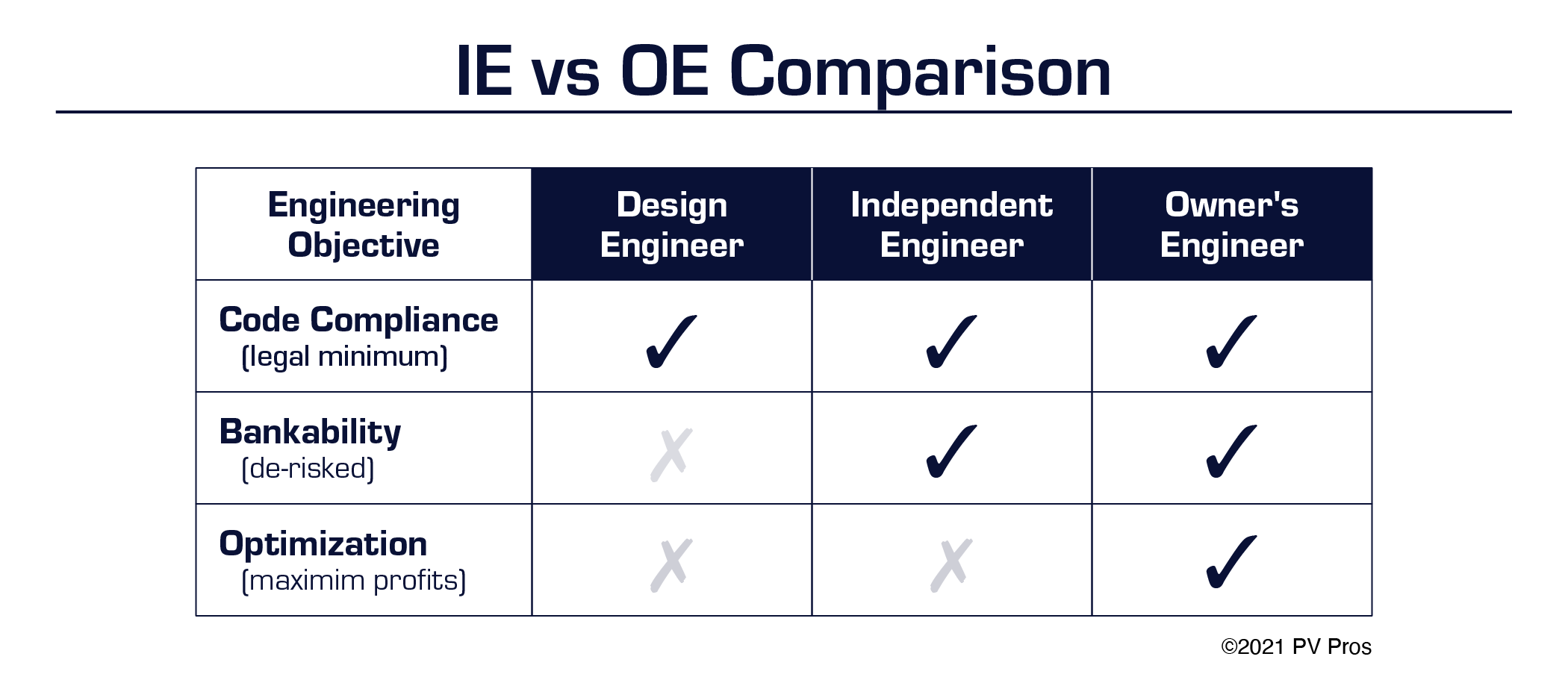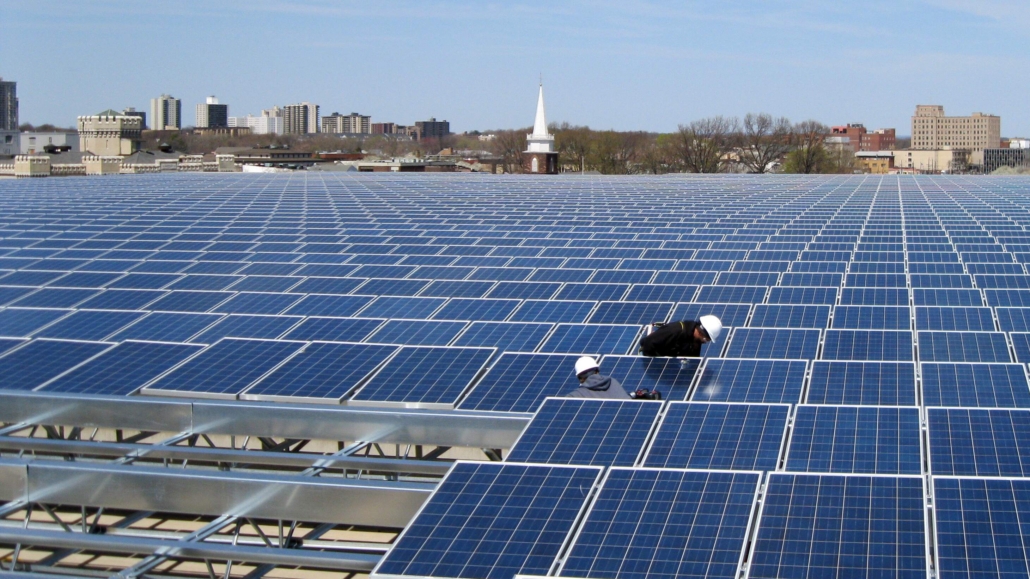When companies do not have in-house engineering—or when an independent third-party perspective is required—outsourcing is common practice. This typically involves engaging an independent engineer (IE) or an owner’s engineer (OE) for professional services. Although these two terms are often used interchangeably, independent and owner’s engineers differ in meaningful ways. Understanding the differences between an IE or an OE will prove useful when determining which is best suited for a specific project or customer profile.
Independent Engineering (IE) Services. In the most general sense, IE’s evaluate all or some of the project with an “independent” mindset not favoring any one party. But in reality, there is more nuance to it.
In the solar industry, an IE is most often in the role of “lender’s engineer” where the IE needs to sign off before a lender or investor releases payments. An IE’s due diligence process de-risks the project by ensuring minimum technical requirements are met, the project is a secure financial asset, and the project is “bankable”.
Side Note: Many use only the term “bankable” to describe tier 1 modules or equipment. We use it to encompass any aspect an IE will review and needs to approve before a lender will release funds. Therefore, the construction drawings, PVsyst report, or installation means and methods, etc. also need to be “bankable”. If an IE wont accept it, lenders wont finance the project, and it’s not “bankable”.
The IE’s bankability analysis ensures that a financier or sponsor will receive regular principal and interest payments, and the asset value is greater than the loan in case of default. As part of reducing financial risk, IEs usually verify code compliance; limit liability exposure; ensure permitting requirements are met; or approve equipment selections.
The IE provides value to the lender and owner by reducing risk. But reducing risk isn’t all an owner needs… what about maximizing profit? That’s where an Owners Engineer comes in…
Owner’s Engineering (OE) Services. An owner’s engineer will go above and beyond the scope of an IE. Representing the asset owner, an OE collaboratively optimizes all technical aspects of a design with the goal of maximizing profits, by decreasing CapEX and OpEx while increasing generation revenue. When engaging an OE, companies can expect an in-depth evaluation of how a system will perform in the field, what challenges may arise in the future, as well as support in decision-making milestones. The aim of owner’s engineering is to reduce or eliminate issues during design or construction instead of passing them on to asset management, operations and maintenance. Ultimately, owners can count on an OE to operate as part of their team and have their best interest in mind.

|
Attention Engineers! Check out our open positions here. |
Value Proposition and Customer Profile
When evaluating engineering service providers, it is important to have a clear understanding of the value each brings to the table. Independent and owner’s engineering are both valuable. However, the optimal problem-solution fit is a function of the client’s business model, motivation and expected outcome.
When to Use an IE. Independent engineering services are most valuable to project sponsors, financiers, lenders, insurance companies and other stakeholders looking for bankability assessments or technical due diligence. Financial and technical security are the primary value proposition of independent engineering services. An IE can validate PVsyst performance model predictions, which are the foundation of return of investment (ROI) and levelized cost of energy (LCOE) calculations. An IE can help ensure that a system is safe to start up and backfeed to the utility grid by verifying equipment compatibility, system sizing and electrical code compliance. In many cases, an IE will have a narrow focus and use a pass/fail acceptance model. When paired with grounded and realistic expectations, an IE may be the right fit for some stakeholders.
When to Use an OE. Owner’s engineering services are most valuable to long- and short-term asset owners looking to optimize solar project ROI. While project owners are the most direct beneficiaries of these types of multidisciplinary and multidimensional activities, other project stakeholders can also benefit from engaging an OE. If your company is looking for an experienced engineering team to serve as an extension of its in-house engineering capabilities, an OE is a valuable partner. A company transitioning from residential PV to large commercial and industrial PV can benefit from working with an OE to avoid mistakes and unforeseen problems. Project developers that will own assets upon completion and act as an independent power producer (IPP) are ideally positioned to benefit from engaging an OE.
Value engineering is one of the primary ways that an OE can bring value to an engagement. The main goal of value engineering is to improve system performance while strategically driving down costs, which maximizes the value derived from the project over time. An OE can also bring value in other ways, such as streamlining the process of achieving project milestones or managing the construction schedule. Approaching the project as a whole, an OE will remain sensitive to the need to accommodate the fast pace of development activities while refining designs through multiple iterations. An OE will also provide guidance about how to adapt designs to site- and environment-specific conditions. By taking a holistic approach, an OE can help clients decrease lifetime costs and maximize profits.

Tips for Selecting an Owner’s Engineer
Don’t assume a great IE will make a great OE. They are different roles with a different skill set and mentality.
IE’s are excellent at raising issues, but they don’t help solve them. IE’s are more black and white, they have their requirements and you pass or fail. IE firms are built to excel in this sort of review and due diligence. Many of the large IE firms have multiple Subject Matter Experts checking their respective areas, and coming up with comments in isolation that don’t take the overall project into account. They are trained to ensure minimum requirements are met and risk is mitigated, but not trained to value engineer, reduce CapEx or OpEx.
To offer the maximum value to an Owner, an OE needs to be a “consultant” that is well rounded in all areas of a project. OEs need to be a consultant for the overall project, not just one small area at a time. OEs need to point out an issue like an IE, but then help solve the issue by developing multiple options and evaluating the best one for each unique situation. Problem solving and consulting is a different skill set essential for OEs.
IEs have a particular function that is essential to deploying capital in solar market. But don’t mistake an IE for an OE. If you need an OE, look for one like Pure Power that specializes in consulting and representing the interests of the owner & IPP.
.png)
